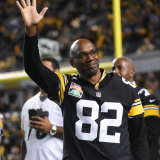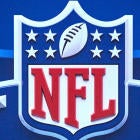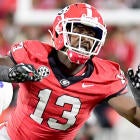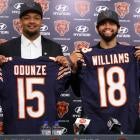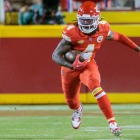
Running backs are starting to become a rare commodity in the first round of the NFL Draft. The short careers at the position -- along with the big second contracts -- have scared teams away from using a premium pick on a running back.
Teams are finding value on running backs later in the draft, players they don't have to consider giving a fifth-year option. Some of those backs are more productive than the top backs selected in the first round, and some teams are even finding stars on Day 3 of the draft (see Aaron Jones and Austin Ekeler). Day 2 and 3 of the draft is when teams tend to invest in running backs in this day and age, as five of the top-10 rushing leaders in 2022 were drafted in the second round or later.
No running backs were taken in the first round in the 2013 and 2014 drafts, a far cry from the four running backs taken in the first round in 2000 and the five taken in 1990 (when the league had just 25 teams).
Is taking a running back in the first round even worth it anymore, especially for teams with a top-15 pick? Some teams have taken the risk with running backs that high, and others have still selected a running back in the first round in the aftermath of the 2014 draft, when none were taken within the first 32 picks.
Which brings up Bijan Robinson, who could be the first running back taken in the top-10 since Saquon Barkley in 2018. Barkley is the only running back taken in the top-20 since 2018.
Let's take a look back at those running backs taken and whether they are still with their original team -- along with the team's success with that running back in the fold.
2021
- No. 24 overall, Pittsburgh Steelers
Harris was the first running back taken in the 2021 draft, as the Steelers had an immediate need for a running back after losing James Conner to free agency. Responsible for carrying the Steelers offense through most of the season, Harris finished with 307 carries for 1,200 yards and seven touchdowns (3.9 yards per carry) while finishing with 74 catches for 467 yards and three touchdowns.
Harris led the NFL with 381 touches, the most by a rookie running back without a fumble since 2000, and set franchise records for rookie rushing yards, receptions, and yards from scrimmage (1,667). Harris was a standout for the Steelers in year one.
In year two, Harris rushed for 1,034 yards and seven touchdowns, averaging 3.8 yards per carry. His yards per receptions went down from 6.3 to 5.6 and receiving yards decreased from 467 to 229.
- No. 25 overall, Jacksonville Jaguars
Etienne never played a down in his rookie season, as he suffered a LisFranc injury in August that ended his first year in the NFL. Former Jaguars head coach Urban Meyer had Etienne lined up at wide receiver in training camp in addition to his duties at running back.
Etienne was the breakout running back in the NFL last season, rushing for 1,125 yards and five touchdowns (5.1 yards per carry). He finished with 1,447 yards from scrimmage and averaged 5.7 yards per touch, ranking ninth in the league in rushing.
2020
- No. 32 overall, Kansas City Chiefs
After winning the Super Bowl, the Chiefs had the option of taking the best player available with the last pick of the first round. They used that pick on Edwards-Helaire, who appeared to be a strong fit for their offense with Patrick Mahomes, Tyreek Hill, and Travis Kelce already setting up opportunities for the rookie.
Injuries have gotten the better of Edwards-Helaire, who has missed a total of 17 games through three seasons. He has 371 carries for 1,622 yards and 11 rushing touchdowns in his three seasons (4.4 yards per carry), along with 72 catches for 577 yards and six touchdowns. Edwards-Helaire has seemed to fallen out of favor in Kansas City, as he was inactive for the Super Bowl in favor of 2022 seventh-round pick Isiah Pacheco.
D'Andre Swift, Jonathan Taylor, and J.K. Dobbins were the running backs taken right after Edwards-Helaire -- all in the second round. Thus far, all of them have had more productive careers.
2019
- No. 24 overall, Oakland Raiders
The only running back selected in the first round of the 2019 draft, Jacobs has been very productive in his four seasons with the franchise. Jacobs started his career with back-to-back 1,000-yard seasons, but this past season was his most productive.
Jacobs was the NFL rushing champion and arguably the most productive back in the one year he was with Josh McDaniels, rushing for 1,653 yards and 12 touchdowns. He also led the league in yards from scrimmage with 2,053 and was the first Raiders player since 1985 to win the league rushing title.
Through four seasons, Jacobs has recorded 1,042 carries for 4,740 yards and 40 touchdowns -- tied for fourth in the league in rushing yards and touchdowns. No running back was taken after Jacobs until Miles Sanders at No. 53 -- and arguably Jacobs has had the more productive career.
Jacobs is the cream of the crop in the 2019 running back class.
2018
- No. 2 overall, New York Giants
Barkley is the highest running back drafted since Reggie Bush went No. 2 overall in 2006. Injuries and a poor offensive line have taken away Barkley's ability to become a game changer, which he was in his rookie season for the Giants.
Leading the NFL in yards from scrimmage (2,028), Barkley was the Offensive Rookie of the Year after he finished with 261 carries for 1,307 yards and 11 touchdowns (5.0 yards per carry) and had 91 catches for 721 yards and four touchdowns. He had the most 100 yards from scrimmage games by a rookie (12) and tied Randy Moss for the most 50-yard touchdowns by a rookie (five).
Barkley missed 22 games over the next three years, yet still became the first Giants running back to record 1,000 rushing yards in his first two seasons. Two separate ankle sprains and a torn ACL since 2019 have limited Barkley, which is why teams caution drafting a running back that high.
Barkley has just 181 carries for 627 yards (3.5 yards per carry) and two rushing touchdowns between 2020 and 2021, with only 47 catches for 323 yards and two touchdowns -- yet had a career resurgence in 2022. Barkley set a career high in rushing yards (1,312) in a Pro Bowl season, finishing with 10 touchdowns.
- No. 27 overall, Seattle Seahawks
Injuries have gotten the best of Penny in his short career, as a torn ACL and numerous knee strains limited Penny to just 27 games over his first three seasons. Penny had just 161 carries for 863 yards and five touchdowns in that stretch, averaging 5.3 yards per carry.
When Penny's healthy, he's been productive. Look no further than the 2021 season when Penny finally was healthy enough to start for the Seahawks. Penny finished his 2021 season with 119 carries for 749 yards and six touchdowns -- leading the NFL with 6.3 yards per carry. In the final five games, Penny had 92 carries for 671 yards and six touchdowns -- an incredible 7.3 yards per carry.
Penny had 57 carries for 346 yards and two touchdowns last season (6.1 yards per carry) before going down with a fractured tibia -- and being lost for the year. In Penny's last 10 games, he has 149 carries for 1,017 yards and eight touchdowns -- an astonishing 6.8 yards per carry. He signed with the Philadelphia Eagles this offseason.
- No. 31 overall, New England Patriots
The Patriots took Michel late in the first round in an effort to improve their running game. Michel had every opportunity to earn the No. 1 running back job in New England, but eventually took a backseat to Damien Harris (a 2019 third-round pick).
Michel finished with 535 carries for 2,292 yards and 14 touchdowns in his three seasons in New England, averaging 4.2 yards per carry. He rushed for 336 yards and six touchdowns in the 2018 playoffs, setting the NFL record for most postseason rushing touchdowns by a rookie.
Foot surgery and a quad strain allowed Harris to claim the No. 1 job from Michel, and the Patriots traded him to the Los Angeles Rams prior to the 2021 season. Michel stepped up in the wake of Cam Akers injury, rushing 208 times for 845 yards and four touchdowns (4.1 yards per carry) -- earning a second Super Bowl ring in the process.
Michel had 36 carries for 106 yards and no touchdowns (2.9 yards per carry) for the Los Angeles Chargers last season.
2017
- No. 4 overall, Jacksonville Jaguars
Fournette had plenty of hype coming out of LSU, enough to be taken in the top five. He made a huge impact on the Jacksonville offense in his rookie season, rushing for 1,040 yards and nine touchdowns despite averaging just 3.9 yards per carry. "Playoff Lenny" was born that season, as Fournette rushed for four touchdowns and 242 yards in three playoff games.
A hamstring strain limited Fournette in year two (averaged 3.4 yards per carry), but he posted his second 1,000-yard season in 2019 by rushing for 1,152 yards and three touchdowns (4.3 yards per carry) while also having a surprising 76 catches for 522 yards.
The Jaguars surprisingly cut Fournette prior to the 2020 season, which resulted in him signing with the Tampa Bay Buccaneers. Fournette made his impact felt in the playoffs by rushing for 300 yards and three touchdowns and having 148 receiving yards and a touchdown -- emerging as the No. 1 back.
Fournette has 4,478 rushing yards and 34 touchdowns in six seasons (4.0 yards per carry) to go with 2,219 receiving yards and seven touchdowns. A free agent for the fourth time at 28, Fournette hasn't lived up to the status as a No. 4 overall pick, but he's a serviceable running back in the league. He also has 858 yards from scrimmage and 11 total touchdowns in eight playoff games.
- No. 8 overall, Carolina Panthers
McCaffrey is one of the best players in the league -- when healthy. He already owns or shares seven NFL records, including becoming the first running back to have 100 receptions in a season twice, and he's the third player in league history to have 1,000 rushing yards and 1,000 receiving yards in a season (Roger Craig and Marshall Faulk are the others).
McCaffrey's 2019 season garnered him first-team All-Pro honors, as he finished with 287 carries for 1,387 yards and 15 touchdowns (4.8 yards per carry) while catching 116 passes for 1,005 yards and four touchdowns. His 403 touches for 2,392 yards and 19 touchdowns each led the league.
Through three seasons, McCaffrey had 2,920 yards and 24 rushing touchdowns (4.7 yards per carry) while having 303 catches for 2,523 yards and 15 touchdowns. That's 5,443 yards from scrimmage and 39 touchdowns.
Ankle, hamstring, and shoulder injuries limited McCaffrey to just 10 games between 2020 and 2021. McCaffrey has 667 rushing yards and six touchdowns, while catching 54 passes for 492 yards and two touchdowns in that stretch. He was traded from the Panthers to the San Francisco 49ers in 2022, where he rushed for 746 yards and six touchdowns (4.7 yards per carry) in his 11 games with the team -- also having 464 receiving yards and four touchdowns.
McCaffrey has rejuvenated his career with the 49ers, having 1,210 yards from scrimmage and 10 touchdowns in 11 games. He's still a matchup nightmare for defenses.
2016
- No. 4 overall, Dallas Cowboys
Elliott lived up to his draft status in Dallas, even if he isn't the same player he was his first three seasons in the league. A difference maker for the Cowboys, Elliott led the NFL in rushing yards per game in each of his first three seasons -- totaling 4,048 yards and 28 touchdowns in 40 games (4.7 yards per carry). Elliott was second in rookie of the year voting and a first-team All-Pro in his rookie season, having 322 carries for 1,631 yards and 15 touchdowns.
Elliott has four 1,000-yard seasons, two All-Pro selections, and three Pro Bowl selections in his career. He's rushed for 8,262 yards and 68 touchdowns while having 2,336 receiving yards and 12 touchdowns. That's 10,598 yards and 80 touchdowns in 103 games.
Since Elliott signed his massive six-year, $90 million contract in 2019, he has 4,214 rushing yards and 40 touchdowns in 63 games. His 66.8 rushing yards per game over the last four seasons is a significant decline over the 101.2 rushing yards per game in his first three seasons.
Elliott was arguably the worst starting running back in the league last season, finishing last in the NFL in yards per carry (3.8), tackles avoided (32), and percentage of runs that went for 10-plus yards (7.4%). His rushing-yards-per-game numbers have declined each season as a result of the number of touches accumulated over the course of his career, averaging a career-low 58.4 rushing yards per game and 3.8 yards per carry in 2022.
He is currently a free agent.
2015
- No. 10 overall, St. Louis Rams
Gurley was out of the league at 27 years old, yet was arguably the best running back in football before injuries started to plaque him. The 2015 Associated Press Rookie of the Year, Gurley rushed for 1,106 yards and 10 touchdowns (4.8 yards per carry) in earning second-team All-Pro honors in his rookie year.
Taking over the league when Sean McVay became the head coach of the Rams, Gurley rushed for 2,556 yards and 30 touchdowns in the 2017 and 2018 seasons -- as the Rams won two NFC West titles and advanced to Super Bowl LIII. Gurley also had 123 catches for 1,368 yards and 10 touchdowns during that stretch.
Gurley's decline started near the end of the 2018 season and spiraled immediately after -- as the knee issues played a role in his production being diminished. Of the 10 running backs with 400-plus carries from the 2019 and 2020 seasons, Gurley was last in yards per carry (3.67) and rushing yards (1,535). Yet, he was fourth in rushing touchdowns (21) during that span.
Gurley has three 1,000-yard seasons, two first-team All-Pro Selections, three Pro Bowls, and an Offensive Player of the Year award. He led the league in rushing touchdowns and scrimmage touchdowns twice -- and yards from scrimmage once. Yet, Gurley is out of football after just six seasons.
- No. 15 overall, San Diego Chargers
The Chargers took a shot on Gordon in the middle of the first round after a standout career at Wisconsin. Gordon hasn't been a superstar, but he's a two-time Pro Bowl selection and has been a reliable back in the league.
Gordon rushed for 6,144 yards and 53 touchdowns in his first seven seasons in the league. He's had one 1,000-yard season (2017) and two double-digit touchdown seasons (2016, 2018) -- not having a season under 600 yards despite having four seasons under 4.0 yards per carry.
Gordon played five years with the Chargers before signing a two-year deal in free agency with the Denver Broncos. He's rushed for 1,904 yards and 17 touchdowns (4.6 yards per carry) in his first two seasons in Denver, thriving in a running back-by-committee approach rather than as the No. 1 back. He returned to Denver in 2022, rushing for 318 yards and two touchdowns in 10 games (3.5 yards per carry) before being released.
Having 8,929 yards from scrimmage and 69 scrimmage touchdowns in his career (eight seasons), Gordon was a reliable back in the league. Just turning 30, it will be interesting to see where Gordon ends up in 2023.





























